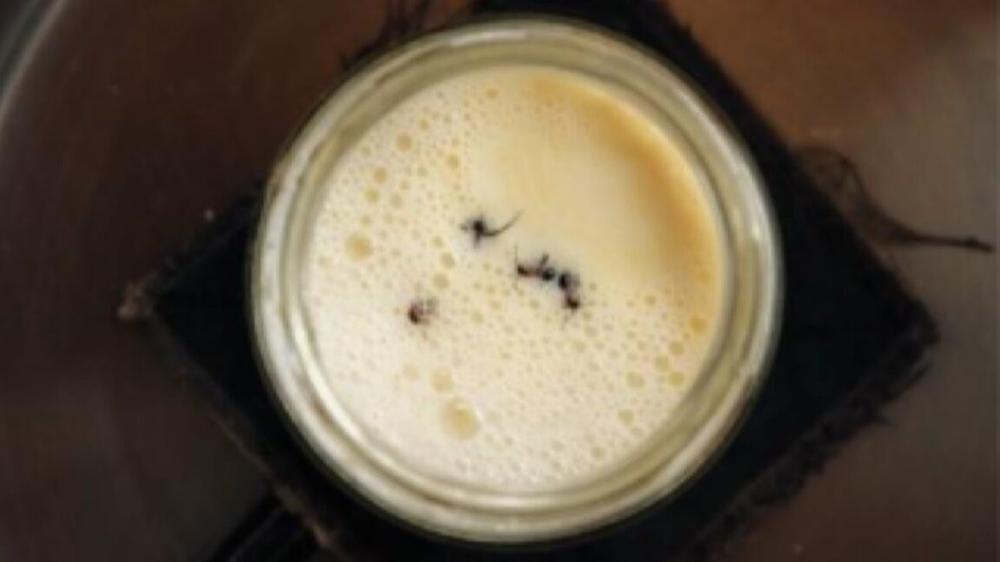Fermenting milk to make yogurt, cheeses, or kefir is an ancient practice, and different cultures have their own traditional methods, often preserved in oral histories. The forests of Bulgaria and Turkey have an abundance of red wood ants, for instance, so a time-honored Bulgarian yogurt-making practice involves dropping a few live ants (or crushed-up ant eggs) into the milk to jump-start fermentation. Scientists have now figured out why the ants are so effective in making edible yogurt, according to a paper published in the journal iScience. The authors even collaborated with chefs to create modern recipes using ant yogurt.
“Today’s yogurts are typically made with just two bacterial strains,” said co-author Leonie Jahn from the Technical University of Denmark. “If you look at traditional yogurt, you have much bigger biodiversity, varying based on location, households, and season. That brings more flavors, textures, and personality.”
If you want to study traditional culinary methods, it helps to go where those traditions emerged, since the locals likely still retain memories and oral histories of said culinary methods—in this case, Nova Mahala, Bulgaria, where co-author Sevgi Mutlu Sirakova's family still lives. To recreate the region's ant yogurt, the team followed instructions from Sirakova's uncle. They used fresh raw cow milk, warmed until scalding, "such that it could 'bite your pinkie finger,'" per the authors. Four live red wood ants were then collected from a local colony and added to the milk.
The authors secured the milk with cheesecloth and wrapped the glass container in fabric for insulation before burying it inside the ant colony, covering the container completely with the mound material. "The nest itself is known to produce heat and thus act as an incubator for yogurt fermentation," they wrote. They retrieved the container 26 hours later to taste it and check the pH, stirring it to observe the coagulation. The milk had definitely begun to thicken and sour, producing the early stage of yogurt. Tasters described it as "slightly tangy, herbaceous," with notes of "grass-fed fat."
To find out more, the authors conducted several lab experiments using worker ants collected locally in Denmark. They made three different versions under sterile conditions, using live ants, frozen ants, and dehydrated ants. They extracted DNA from the ants and the resulting yogurt to identify the microbes that were present and measured the bacterial loads, among other properties.
It turns out that the ants naturally contain both lactic acid and acetic acid bacteria—one species was very similar to the bacteria found in commercial sourdough starters—and these bacteria help coagulate the milk. Ants also carry formic acid as part of their natural chemical defense system, which acidifies the milk and creates the perfect environment for acid-loving microbes to thrive. Both the ants and the microbes contribute enzymes that help break down milk proteins to create yogurt. Only the live ants produced the desired microbial community.
A pinch of red wood ants
Using ants for fermentation likely evolved as a makeshift method when starter cultures were in short supply. But would anyone in the 21st century voluntarily eat ant-made yogurt? To find out, the authors turned to Alchemist, a fine-dining restaurant in Copenhagen, Denmark, that boasts two Michelin stars. Alchemist very much falls under the molecular gastronomy rubric, known for providing a dining "experience," not just a fancy meal. So their chefs were an excellent choice to collaborate with to transform basic ant yogurt into various culinary delights. The chefs devised three recipes. (Ant body parts were removed via a strainer, for what it's worth.)
The first was an "ant-wich" (their version of an ice cream sandwich), made with ant yogurt ice cream with an ant gel filling within a delicate egg-white tuile, colored black with charcoal, and then stenciled via laser cutting into the shape of an ant. The second was an "ant cheese," similar to marscarpone, in which ants were used as the coagulant instead of the usual citric acid.
Finally, there was an aperitif cocktail clarified with ant milk wash—their version of the traditional Milk Punch dating back to the late 1600s (although the earliest written recipe was published in 1711). Once again, the ants were used as a coagulant for the milk wash, mixed with an alcoholic base of brandy, genepi liqueur, and apricot liqueur and garnished with four frozen ants.
The authors advise against making your own ant yogurt at home. The ants may carry parasites that could endanger human health. "Therefore, we caution against the general application of this fermentation, unless (a) practitioners maintain this as part of their heritage and cultures of food safety, or (b) practitioners have knowledge in food microbiology to allow for adequate food safety," they concluded.
If all this sounds too gross for words, bear in mind that in many cultures, ants and other creepy crawlies are considered delicacies. For instance, indigenous Brazilian people have eaten Ica leafcutter ants for centuries, sometimes called "Brazilian caviar." There's even a brand of award-winning gourmet cheese (Taiada Silvania) spiked with toasted Ica ants, described as having "notes of almonds and chestnuts, a slight fennel flavor, and the unmistakable crunch of ants."
We'll just call it an acquired taste.
DOI: iScience, 2025. 10.1016/j.isci.2025.113595 (About DOIs).

 These Are the 10 Best Books to Look Out for in October 2025
These Are the 10 Best Books to Look Out for in October 2025